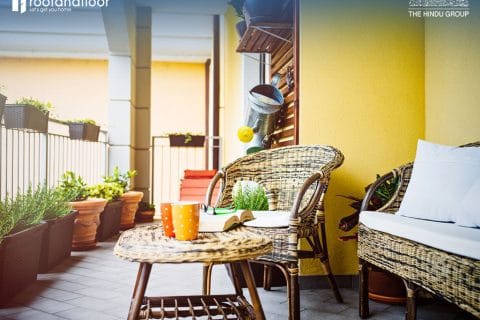As homeowners everywhere are becoming more conscious about the need to go green, interior designers are looking at following sustainable practices in home décor. Sustainability is more than just a fad— it’s our duty! By following eco-friendly practices, we can ensure that our actions do not negatively impact our future generations.
Would you like to incorporate sustainable principles in your home? This Earth Day, here’s how you can make a start!
Design for energy efficiency
An energy-efficient home will have low power bills as it uses natural energy resources such as solar power, water and wind, thereby creating a healthy and safe living environment. Intelligent designers must harness the advantages that come from making the best use of natural resources that are responsive to the local climate as well.

Some ideas to get you thinking:
- Large windows toward the east and west can capture the rays of the sun but could make the inside of your home uncomfortably hot in the summers, increasing the need to use electric fans. Instead, opt for windows that do not directly align with the sun’s rays but let in natural light into your spaces.
- Opening windows that are placed diagonally opposite each other will allow a free flow of fresh, natural air across the room.
- By installing faucets with aerators, you can ensure optimal use of available water. Watch out for drips and leaks and get them fixed at the earliest; just one dripping faucet wastes five gallons of water in a single day!
- Use lights and fans that are powered by clean, renewable solar energy, and avoid the use of air conditioners whenever possible.
- Plants are natural temperature regulators, improves air quality, and creates a sense of well-being.
Choose organic materials
By choosing materials that have the lowest environmental impact, you can reduce your carbon footprint. Try to source materials that are:
- Available locally, and
- Extracted in an environmentally responsible way
For example, organic cotton is produced without harming the environment and is biodegradable, while synthetic materials like polyester use harmful manufacturing processes, and the end products do not decompose for centuries. Point to note: that plastic bag that you just threw away will still be around 200 years from now!
If you live in an area where mud is plentifully available, consider building your home using mud blocks. Bricks and terracotta are also materials that are made from the earth.
Bamboo, rattan and jute are sustainable crops as they have naturally renewing properties. Furniture made of these organic fibres is durable, resilient, and cost-effective.
Rubberwood, a strong and flexible wood, is considered eco-friendly as it is harvested from trees that are past their useful latex yielding stage.

Reduce and manage waste
Our natural resources are limited and dwindling, and there is a real need to incorporate recycling and upcycling practices in our homes.
Creative designers can think of innovative ways to breathe new life into objects that are past their useful life. Storage made of old wooden crates, seating made of discarded rubber tyres, or upholstery made of old fabrics that are quilted together, are some sustainable trends that can give new purpose to old products, saving them from landfills.
Wastewater systems should be designed to manage greywater and reuse it for gardening, and food waste can be composted to create organic fertiliser. Rainwater harvesting catches the surface runoff and recharges the groundwater reserves.

Flexible and durable design
Home interiors should be designed keeping longevity in mind. Opt for materials that will last and furniture and furnishings that can be handed down from generation to generation without ending up as waste. By choosing elements that are sturdy and durable, you will spend less on maintenance over the years and generate less waste.
Design flexible furniture that will last, such as a sofa that can do double duty as a bed at night or a bunk bed that can be separated into two single cots when your children grow up. Choose authentic pieces that emphasise quality and durability over quantity.
Modular cabinets that are built using good quality materials can be re-assembled in new configurations and locations, saving on material costs. When spaces are designed by anticipating future changes, we can keep more waste out of landfills.

Design for health and well-being
All of us spend a great deal of our lives indoors, and by designing healthy spaces, we can ensure the well-being of our family. Often unrecognised, indoor air pollution is very detrimental to our health. Interior designers should use materials that are considered environmentally safe and that do not release toxins into the air.
Picture this: your little one is playing on a vinyl floor that contains carcinogenic dioxins. The air she breathes contains VOCs from the paint on the walls, and the sofa in the room is padded using synthetic polyester material that could have serious health consequences in the long term! Laminated finishes in the furniture leach formaldehyde into the air, while the colourful rug has been treated with strong carpet dyes.

Worrisome? Unless you make mindful choices, your loved ones will be at risk of developing serious illnesses!
Are you doing all you can to reduce your carbon footprint? Think:
- Use cushions filled with wool or organic cotton, not polyfill. Polyester fiberfill contains toxic chemicals, takes over 200 years to decompose, and is believed to be one of the biggest sources of microplastic pollution in landfills and oceans.
- If you are using wood, look for ecologically sourced wood with the Forestry Stewardship Council (FSC) label. This wood is obtained from forests that are carefully conserved and managed using approved bio-diversity guidelines.
- Upcycle, recycle, and reuse wherever possible! The more materials you can save from landfills, the better for our planet.
- Make a conscious decision to use furnishings and materials that are composed of zero or low VOCs (volatile organic compounds). VOCs are slowly leached or off-gassed into the indoor air, raising levels of toxicity within your home.
- Some plywood, boards and laminates are bonded using formaldehyde and release toxins over time. Laminate waste is plastic and cannot be recycled, making it a prime candidate for landfills. Particleboards have been known to off-gas for as long as two decades and can contribute to chronic illnesses in your family.
- Some VOCs in wall paint are known to be carcinogens. Choose paints that contain less than 50 grams of VOCs per litre.
- Swap out all the lights at home with LED lights, as they use far less power and can potentially cut your energy bills by a whopping 80%.
Our planet is in crisis, and if we fail to act now, there’s no turning back from the inevitable consequences. This Earth Day, let’s join hands to go green!
This article is contributed by Dipti Das, AVP-Design, HomeLane.com.
(The views expressed here are solely those of the author and do not necessarily represent or reflect the views of RoofandFloor)





